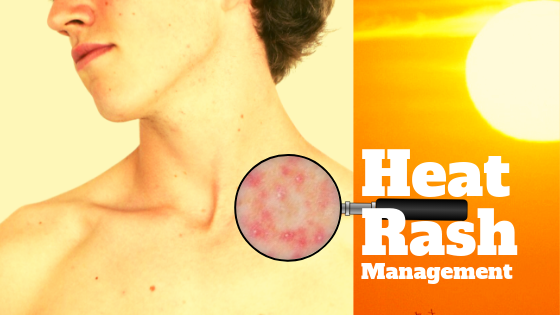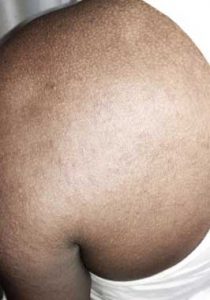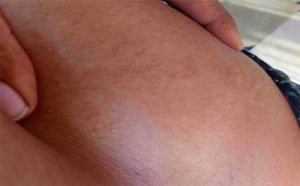Heat Rash (Miliaria) – Causes and Management

Table of content
What is Heat Rash?
Heat Rash or Miliaria is characterized by tiny red or white raised dots or lumps on the skin which can be very itching and irritable. Although it is commonly seen in babies, it can affect children and adults too. It is also called “Prickly heat”, as the name suggests the patient gets a warm and prickly feeling over the rash.
It is common in warm and humid weather conditions, such as during summer months. Heat rash is commonly seen in people in tropical countries. Heat rash when left alone will go off with time, especially once the weather conditions are reversed.
What causes the Heat Rash?
There are sweat glands in the skin which sweat is produced. Perspiration comes out to the skin surface through pores or sweat ducts. These pores can get blocked sometimes, leading sweat to be settled inside or trapped under the skin.

What are the Symptoms of the Heat rash?
The symptoms of Heat rash can vary from tiny raised red or white dots which are superficial to tiny blisters or red lumps which can go deep.
Itching can vary from person to person. Although commonly mild, few people can get severe itching in the area of the rash.
Heat rash is mainly seen over the chest, neck, and shoulders in babies. In children and adults mainly neck, chest, and back get involved. It can commonly involve places where you sweat more or in skin folds where clothing leads to friction such as elbow creases, armpits, and even groin.
Understand your Skin Disorders
Use our online AI app to learn about your skin conditions
When an eczema patient is exposed to heat, it gives an itching sensation exacerbating eczema. The normal mechanism of the body’s sweating in hot conditions to cool down worsens the condition in eczema. Moreover, when the sweat evaporates leaves the sodium in the skin making it drier and itchier.

How do you classify Heat rash?
There are several types of Heat rash divided according to the severity and how the rash looks.
Miliaria Crystalina
This form of heat rash is very mild. Sweat ducts are blocked from above, closer to the skin surface. There are tiny fluid-filled blisters and bumps. The fluid inside is clear. Itching can occur but not so intense. The rash is mild and when scratched these blisters can break.
Miliaria Rubra
“Rubra” as the name suggests, the rash is red. The reaction occurs deeper in the ducts. Itching and the prickly feeling is more when compared to the previous form.
Miliaria pustulosa
The small blisters get infected and become pustular or filled with pus. The area becomes inflamed and red. The rash looks more severe.
Miliaria Profunda
This form of heat rash is severe. The involvement of the rash is deep within the skin. It is not a common type. As the perspiration which was blocked inside leaks out to the skin, flesh-colored firm bumps are formed in the skin and looks worse and more severe than all the 3 types mentioned above.
How do you prevent getting Heat Rash?
Although Heat rash can be completely cured it can always recur due to warm humid weather conditions and increased sweating. Try the following tips to keep heat rash at bay
- Avoid going out in warm, humid weather
- Keep the skin cool
- Wear breathable clothes and avoid multilayer clothing
- Maintain cool temperature at least in your house and office using air conditioner or air cooler
- Avoid sweating a lot – use deodorants
- Avoid Heavy workouts or physical training that cause you to sweat
- Take a shower after traveling, or exercise to rinse off the sweat
- Avoid greasy creams and ointments which can block pores more
- Avoid occupational exposure to heat as much as possible
Home remedies and Over the counter medication
Usually, a mild form of sweat rash does not need any treatment. Once the reason for the rash has eliminated the rash will settle on its own.
- Cool your skin by frequent cold water baths
- Use fans or air conditioner to prevent sweating
- Avoid heat exposure – There are certain occupations like firefighters, factory workers, lab workers, out-door workers who spend a lot of time in hot humid conditions. These people will have to cool off their bodies as much as possible during non-working hours.
- If heat rash is spread throughout, use soft cotton, loose clothes to avoid friction with the skin.
OTC products for Heat Rash
There are several OTC products available in the market to treat heat rash. Such as;
- Calamine lotion to soothe the rash
- Lotions or Creams containing Zinc oxide and menthol – for the soothing effect
- Products which contain Anhydrous Lanolin – This prevents blocking of sweat ducts and new rash formation will be stopped
- If the rash is associated with inflammation and redness can try 1% Hydrocortisone cream, which is a mild steroid and is available over the counter.
- If itching is difficult to bear can try an oral antihistamine like chlorpheniramine 4mg, Loritidine 10mg, Fexofenidine 180mg or cetirizine 10mg. Be cautious about the dose and frequency of administration.
- When buying an OTC product always check for expiry date and instruction leaflet.
How do you know whether your Heat rash is infected?
- If you feel a burning sensation or pain in the area
- If the swelling and redness increase
- If you develop a fever and even chills
- Pus may pore out from the lesions and you will feel sticky
- There will be swollen lymph nodes (If the infected rash is over neck lymph nodes will get swollen along your neck. If the infected rash is over arms and shoulders there will be swollen lymph nodes in your armpits. If the infected rash involves groin area and upper thighs, the lymph nodes will be found in the groin)
If the Heat rash is severe and infected you may need a prescription for a course of antibiotics from a qualified medical practitioner. When the heat rash is severe usually steroid creams are prescribed to be used once or twice a day for some time depending on response.
When should you seek help?
- When the rash disturbs your day to day activities and sleeps due to severe itching and irritability
- Babies with heat rash – Especially when they cry a lot than usual
- When the rash does not settle with home remedies and over the counter products which were used by you
- When the Heat rash is severe and looks angry
- When the Heat rash has features of infection






